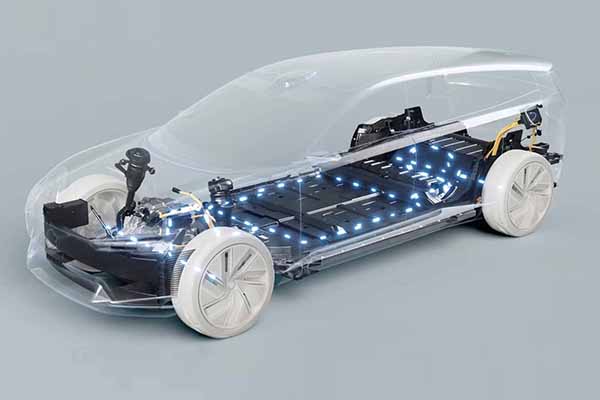Unlike a single energy storage element such as a fuel tank, an electric vehicle (EV) battery pack consists of hundreds of individual lithium-ion (Li-Ion) bat-tery cells in a long series. When not operated within a carefully controlled range, the capacity and lifetime of these battery cells diminish and diverge over time and operating conditions. A battery management system (BMS) is responsible for extracting the maximum capacity and lifetime from these cells while ensuring safety and reliability. At the heart of this system are battery cell monitors that provide the cell measurements used to determine every cell’s state of charge (SOC) and state of health (SOH)—the key parameters for evalu- ating a cell’s status. This article introduces Analog Devices’ ADBMS6815 family of high voltage battery cell monitors and the key differentiating features that enable maximum capacity, safety, reliability, and lifetime of an automotive battery pack.
Introduction
For decades, the automotive industry has slowly consolidated, while technology and brand differentiation has decreased. The powertrain, the system that transfers energy into motion, is arguably the auto manufacturer’s most prized intellectual property, with more than a century of refinements behind it. In this context, the emergence of entirely new automotive companies is nothing less than remarkable since the powertrain technology is the one that is being challenged.
A typical internal combustion engine (ICE) vehicle has a 15-gallon fuel tank, which is equivalent to nearly 500 kWhr of electrical energy. 15 gallons of gasoline translates to a range of 375 miles in an ICE 500 kWhr of electrical energy translates to a range of 1450 miles in an EV. This enormous efficiency advantage is why EVs will eventually triumph, but the last leg of this journey is yet to be mapped out. The biggest problem facing today’s generation of EVs is that they cannot carry enough battery capacity to match the range of an ICE vehicle.
What Is the Challenge?
The battery pack of an EV consists of hundreds of individual battery cells, operating in series to create voltages from 400 V to 800 V. Overcharging and over discharging can damage or prematurely age a cell, which can reduce capacity or lifetime, and eventually cause cell failure. The primary function of the battery management system is to determine and control the SOC and SOH for every cell in the long series that make up a pack. Charging any Li-Ion cell to 100% of its SOC or discharging to 0% SOC will degrade its capacity. Determining SOC requires measuring cell voltage and temperature, and the accuracy of these measurements directly determines how well SOC can be managed. In sum, the BMS electronics are the lynch pin for maximizing operating range, lifetime, reliability, and safety of an EV’s battery system.
It is no simple feat to accurately and continuously measure all battery cells connected in a long, high voltage string in a tightly coordinated way. Measurements need to be immune from the corruption of high electrical noise created by inverters, actuators, switches, relays, etc. The electronics themselves need to be electrically isolated due to the high voltages of the pack. And finally, the electronics need to operate for years through wear and tear, weather, and the age and mileage of a vehicle.
At the Heart of the BMS

As a leading provider of integrated circuits (ICs) and solutions, ADI’s battery management products focus on a few key areas: individual cell measurements (cell monitors), overall pack measurements (pack monitors), communication networks to interconnect devices (via wires or via a wireless network), and software to control these devices. The goal for these electronics is to allow all battery cells to be safely charged to the highest possible capacity, ensuring that the complete pack obtains the largest storable energy to maximize the vehicle range.
Arguably, the most critical device is the high voltage cell monitor IC. Cell monitor ICs measure the cell voltages and temperatures of series-connected battery cells, typically 12 cells per monitor. Cell voltage and temperature are the key parameters; measurement accuracy and synchronicity are the key characteristics.
Combined, this information enables the battery management system to operate the cells at the full extent of their safe operating range without stressing them. So, the performance of these cell monitors is critical for a BMS to maximize a vehicle’s range, cost, weight, and reliability. Since measurement error translates to less effective battery man- agement, ADI’s battery management system products have always offered the industry’s most accurate measurement capability.
ADI’s recent introduction of the ADBMS6815 family of precision cell monitors offers an ideal combination of features to achieve safety, performance, and cost- effectiveness. This family consists of three basic devices, differentiated by the number of cells that each monitor: The ADBMS6816 monitors six battery cells, the ADBMS6817 monitors eight battery cells in series, and the ADBMS6815 monitors 12 battery cells in series. The three different cell monitor counts can address different cell configurations for a wide range of battery pack configurations.
Furthermore, these parts can be combined in a mix and match fashion to create an ideal quantity of cell monitor channels. Because the operating environment includes extreme electrical noise, they also include adjustable low-pass filtering that reduces this noise, ensuring high fidelity measurements.
ADI BMS Communication Technology
The ADBMS6815 family of cell monitors are designed for daisy-chain interconnection using a 2-wire communication interface called isoSPI™. This is a robust, EMI- insensitive, and electrically isolated network that allows ADI’s BMS devices to be operated, polled, and controlled synchronously from the BMS microcontroller. This enables all cells in the pack to be measured synchronously with pack current and pack voltage using an ADI pack monitor device. This daisy chain can be operated with one path to each device, or with dual paths in a loop configuration. The loop allows for access to all of the cell monitor data in the event that a wire or connector fails.
The ADBMS6815 family also supports operation in a wireless battery management system (wBMS), where the wired daisy chain is replaced with a 2.4 GHz wireless BMS node at the cell monitors.
Safety
Among all the goals of a BMS, ensuring that the battery pack is safe is the most important. Recognizing and remedying potential failures within an IC requires built-in self-test capability and redundancy. These functions include redundant measurement paths, improved synchronization between input signals, self-test capability, and many more.
The ADBMS6815 family of parts has been designed to support the ISO 26262 ASIL-D standard.
ISO 26262 is a universally adopted automotive functional safety standard, designed to ensure safety throughout the lifecycle of automotive electrical equipment and systems. ASIL-D is a risk classification within this ISO standard that represents the highest level of automotive safety in a system. ADI’s components are designed and certified to support ASIL-D to ensure that automotive manufacturers using ADI’s components can achieve this critical milestone.
Furthermore, by meeting the ISO 26262 standard, designers can generally address other functional safety standards such as IEC 61508 to meet the standards for nonautomotive applications, as well.
Low Power Cell Monitoring
In addition to ensuring a stable, predictable, and reliable source of energy to power the vehicle, the BMS must ensure that the cells themselves are always safe. While it is a rare occurrence, a battery cell defect can cause a cell to short over time and lead to thermal runaway with catastrophic results. For this reason, the BMS monitors for conditions that could indicate any potential problem.
Battery cells are not inert just because they are not in use. As electrochemical devices, they change over time even when at rest. In other words, the progression of a failing cell can continue even while a vehicle is not operated. To provide continuous monitoring of the cells within a battery pack, even while a vehicle is in a key-off state, ADI has developed low power cell monitoring (LPCM). LPCM is an advanced cell monitoring feature that periodically and autonomously checks key parameters of the battery cells. With the LPCM feature, the cell monitors alert the BMS to wake up and run appropriate checks if they detect any potential concerns. The BMS is also alerted if the cell monitors fail to provide a periodic positive confirmation.
To learn how ADI solves this problem, check out this video explaining LPCM.
Flexibility, Capability, and Cost-Effectiveness
The ADBMS6815 family offers an ideal combination of features to address a broad range of requirements, complementing the safety, reliability, and performance already outlined. These devices use the same package and pinout, allowing designers to combine the different channel counts (6, 8, 12 battery cells monitored with each device) to create a general design that can be populated to address a broader range of battery pack or cell module configurations. These parts also include general-purpose I/O that can operate as digital inputs, digital outputs, or as analog inputs. When operated as analog inputs, they can measure any voltage up to 5 V with the same measurement accuracy as the primary cell measurements. Furthermore, these auxiliary measurements, such as temperature or current, can be synchronized with individual cell measurements for more accurate SOC calculation. These I/O pins can also control I2C or SPI subnode devices, enabling more complex functions, such as the addition of multiplexers for expanded analog inputs or EEPROM to store calibration information. Finally, these parts include cell balancing capability whereby up to 300 mA of current is discharged on any cell. This enables the system to equalize and maintain an equal SOC among all cells in the pack. The equalizing process can be set up for a specific period, and automatically stopped when preprogrammed thresholds are achieved. This allows balancing over a long period, even while the battery cell monitor is in sleep mode.
Common Features
X ADBMS6815 (12-channel) X ADBMS6817 (8-channel) X ADBMS6816 (6-channel)
- Supports automotive safety integrity level D
- Maximum lifetime total measurement error: 1.5 mV
- Stackable architecture for high voltage battery packs
- 304 μs to measure all cells in a system
- 16-bit ADC with programmable noise filter
- 300 mA per channel passive cell balancing with programmable PWM control
- 2 Mbps electrically isolated isoSPI communication
- Uses only 2 wires and capacitors or transformer
- Reversible communication supports ring-topology; allows for communication even with a fault along the communication path
- 7 general-purpose interface pins usable as analog or digital inputs or digital
- outputs; supports temperature sensors and configurable as an I2C or SPI main
- 5.5 μA sleep mode supply current
- 48-lead 7 mm × 7 mm LQFP package
Conclusion
Within the next 30 years, the world will transition from ICE to electric passenger vehicles. The enormously inefficient use of gasoline, a product derived from a limited resource, will ensure that this happens. Geopolitical and environmental concerns will only accelerate the trend. Electric cars are the future and BMS technology is a key enabler.
Leading-edge BMS products, such as the ADBMS6815 family, are enabling the future. These ICs are certified ISO 26262 ASIL-D compliant, and they offer the industry’s highest battery cell voltage and temperature measurement accuracy. The ADBMS6815 family follows many generations of road-proven battery monitor ICs, designed to surpass the environmental, reliability, and safety demands of automotive and industrial applications. They continue to efficiently address the evolving and chal- lenging requirements for EV fleets and large energy storage systems. Designers can select ADI, confident that our market leading technology delivers the best possible battery management system today and establishes a path for leading-edge systems based on our ever-expanding innovations for tomorrow.















